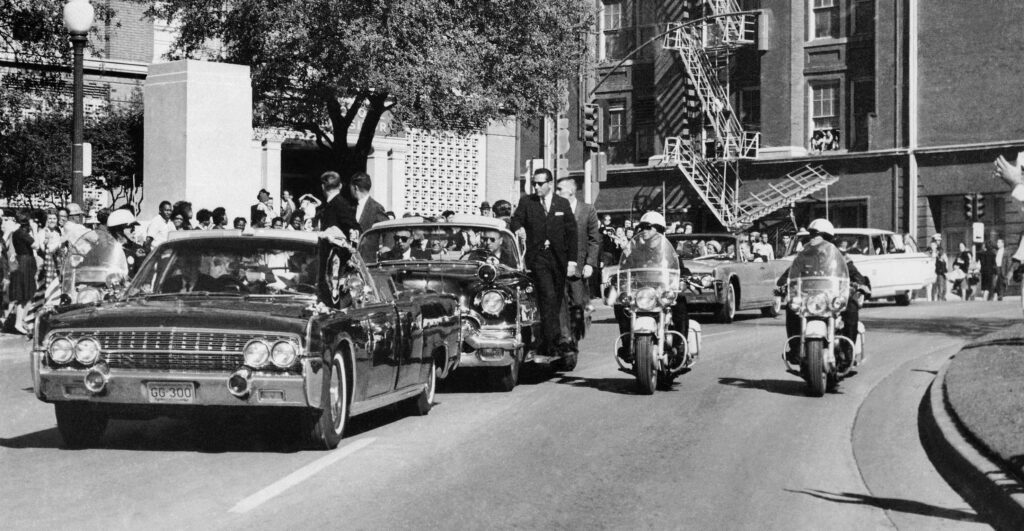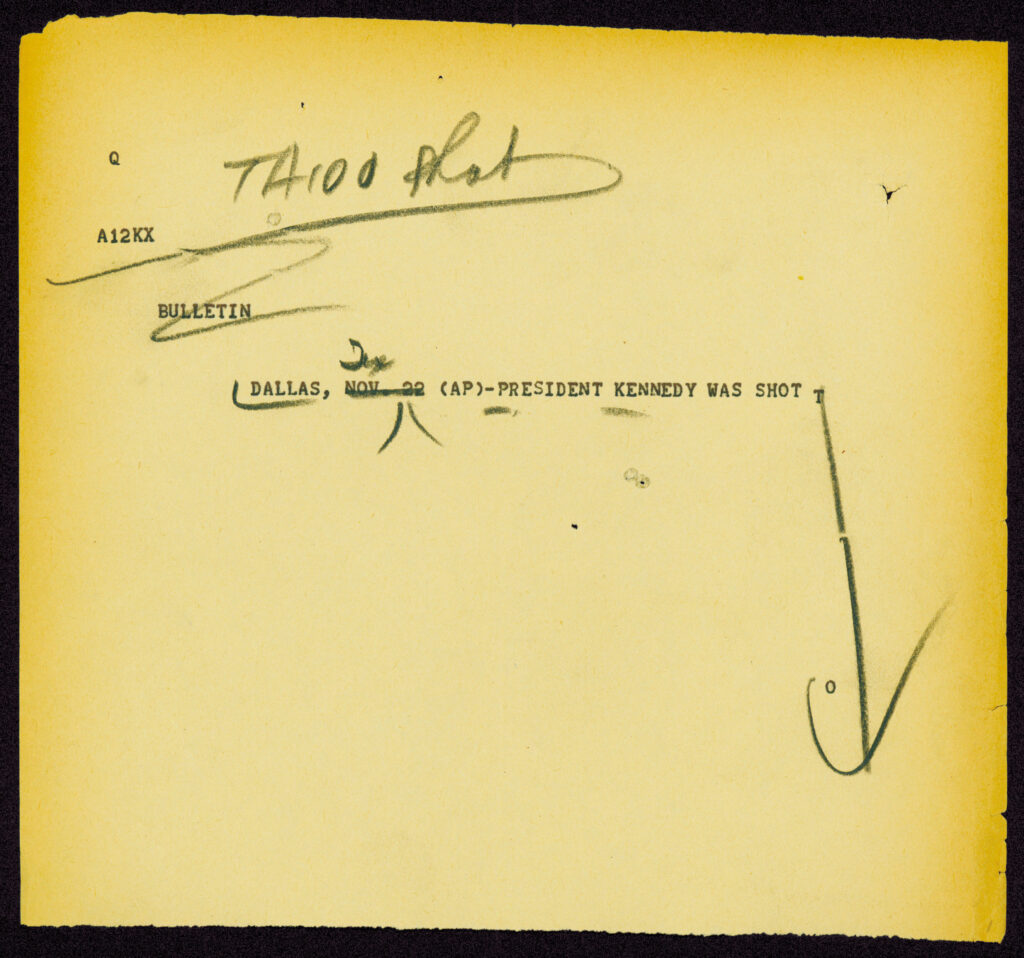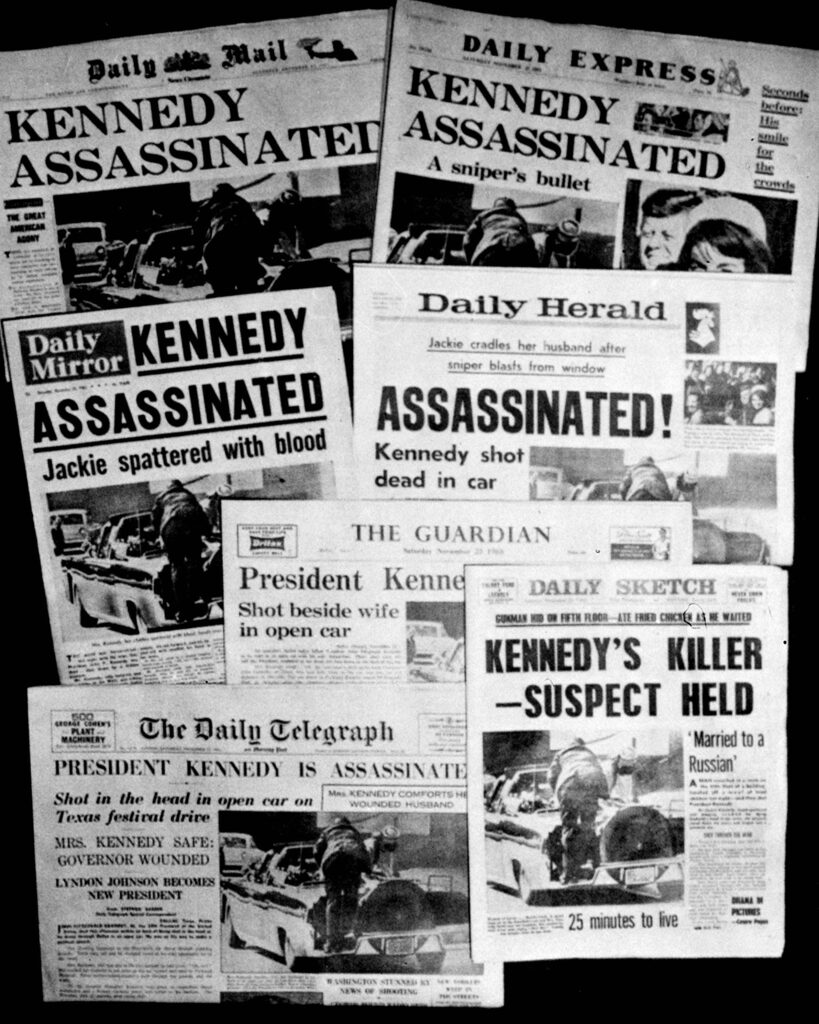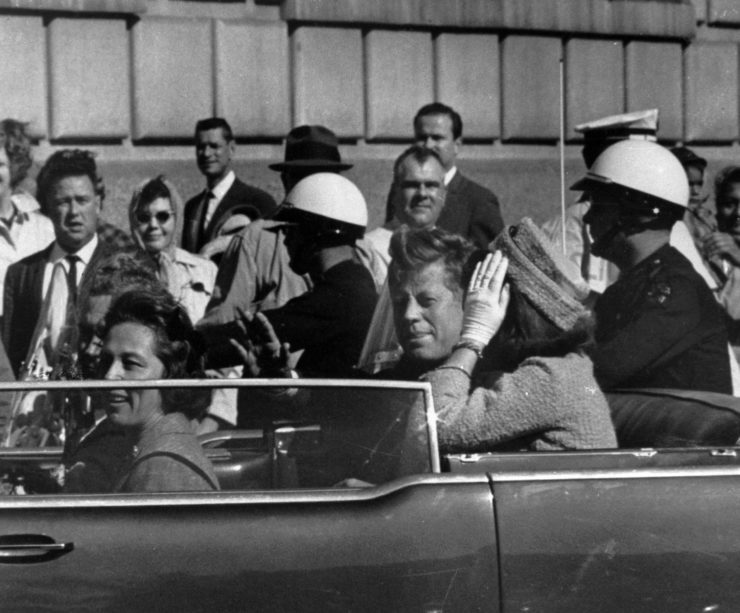In this time of political shockers, it seems a good time to revisit the biggest political shocker of the American 20th century: the assassination of President John F. Kennedy.
Today is the 53rd anniversary of the killing, and so much separates us from that moment: a sense of innocence lost versus cynicism confirmed; telephones connected by wires versus Bluetooth phones in our ears; a near-monopoly of print, TV and wire services delivering the news versus a dizzying array of digital outlets, from traditional sites to startups to social media.
I think Smith’s experience and knowledge of the beat were critical to his ability to get the assassination story first.
But one thing hasn't changed: beat journalists at the top of their game.
Which brings us to Merriman "Smitty" Smith, the dean of White House correspondents at the time of the assassination, who won a Pulitzer Prize for his reporting on the day (for a story that apparently wasn't touched by his editor -- not even the punctuation).
When longtime journalist Bill Sanderson began reporting on Smitty for what became the biography "Bulletins from Dallas: Reporting the JFK Assassination," he says, "I worried that the story of the JFK assassination had been picked clean -- that all the conspiracy theorists and other authors had dug up everything there is to dig up. Was I ever wrong about that."
The book is full of reporting derring-do that will make journalists' hearts swell (can I be the first to suggest a "Spotlight"-like movie?): Near-fisticuffs in the press car in the motorcade as Smitty hogged the phone; the wire bulletin that beat the pants off the competition; a clever rewrite guy commandeering the payphone at Parkland Hospital with 1960s technology knowhow; all leading to a day's-end narrative that will make you catch your breath.
I asked Bill a few questions about the book. Here are some of his answers. (Yes, it's nowhere close to 5 Questions, or even 5(ish) Questions. But his stories are fascinating.)

What made you want to write this book? How did it all begin?
After I left my job at the New York Post in 2013, I looked for freelance writing assignments. One day Faye Penn, at the time an editor at the New York Observer, called and asked me to write something about the 50th anniversary of the Kennedy assassination. That led me to track down a number of reporters who were in Dallas that day. I’d long been fascinated by how Merriman Smith of UPI beat the AP reporting the assassination -- I first read about it in an article by Patrick J. Sloyan -- I decided to use my reporting for the Observer story as a jumping-off point for a book.
When Lee Harvey Oswald fired three shots at President Kennedy at 12:30 p.m., some reporters thought it was motorcycle backfire, or maybe firecrackers. But Smith recognized the sound right away — gunshots. He grabbed the radiotelephone and called the Dallas UPI bureau. “Bulletin precede,” he yelled. Those two words signaled to UPI that he had news that would supersede the other Kennedy stories he’d filed that day.
Smith is the man who broke the news of the shooting of JFK to the world. Cronkite read HIS dispatch. Tell us a little about what kind of reporter he was and how he pulled it off.
First off -- everyone called him Smitty, and I find I lapse into that when I tell his story.
Smitty was the ultimate beat reporter. He started at the White House a few months before Pearl Harbor, and by the time of the Kennedy assassination, he’d been on the beat for 22 years. He knew everybody at the White House -- gardeners, butlers, Secret Service agents and everyone else right up to the president himself.
Jim Hagerty, Dwight Eisenhower’s press secretary, said Smith had so many White House sources it was impossible to keep him from learning what was going on. But Smitty knew there was more to covering a beat than good sources. He understood how the White House worked -- its habits and rhythms. When news broke that Eisenhower had had a heart attack in Denver in 1955, Smith knew instinctively the White House would soon send a plane there. He called Hagerty right away. Hagerty told him to be at the airport in an hour. Smith was the only reporter aboard that flight. Hagerty said he would have taken others too, but Smith was the only reporter who knew to ask.
I think Smith's experience and knowledge of the beat were critical to his ability to get the assassination story first.
You've got to describe the scene from the press pool car, how Smith claimed the front seat and the fight between Smith and the AP's Jack Bell.
White House reporters called the pool car the wire car, because it always carried reporters from the AP and UPI wire services. The wire car carried four reporters in Dallas on Nov. 22, 1963 -- Smith, AP reporter Jack Bell, Bob Clark of ABC News and Robert Baskin of The Dallas Morning News. The wire car was equipped with a radiotelephone. In Dallas, the wire car traveled several car lengths behind Kennedy’s limousine. Most of the other 54 Washington journalists on the trip rode buses way at the back of the motorcade.
Smitty was always alert and always had in mind that anything could happen at any time. He didn’t expect anything to happen that day. But just in case, he wanted, as always, to be in the best position to observe and report any news. So he made sure to be in the front seat of the wire car. That would give him a good view of anything that happened. And the radiotelephone’s location next to the front seat meant that if there was news, Smith could grab the phone and tell his editors right away.
Understand it in today’s terms: All the reporters in the motorcade shared one mobile phone -- and Smith sat next to it. Another important factor in what happened that afternoon: Jack Bell, who sat in the back seat, was not a White House reporter. He usually covered Congress. Bell didn’t have Smith’s instincts when it came to covering the White House beat.
It also helped that Smitty was what we’d call today a gun nut. He liked hunting and shooting, and he owned several guns and rifles.
When Lee Harvey Oswald fired three shots at President Kennedy at 12:30 p.m., some reporters thought it was motorcycle backfire, or maybe firecrackers. But Smith recognized the sound right away -- gunshots. He grabbed the radiotelephone and called the Dallas UPI bureau. “Bulletin precede,” he yelled. Those two words signaled to UPI that he had news that would supersede the other Kennedy stories he’d filed that day.
Wilborn Hampton, the young reporter who answered the phone, took Smith’s dictation and typed the first dispatch: “Three shots fired at President Kennedy’s motorcade today in downtown Dallas.” This moved on the UPI wire at 12:34 p.m., four minutes after Oswald fired.
Understand it in today’s terms: All the reporters in the motorcade shared one mobile phone -- and Smith sat next to it. Another important factor in what happened that afternoon: [The AP's] Jack Bell, who sat in the back seat, was not a White House reporter. He usually covered Congress. Bell didn’t have Smith’s instincts when it came to covering the White House beat.
After he wrote Smith’s dispatch, Hampton handed the phone to Jack Fallon, who was the top UPI editor in Dallas. Luckily for UPI and Smith, Fallon was one of UPI’s very best writers. His work as a rewriter helped United Press, UPI’s predecessor, win a Pulitzer for reporting the 1956 Hungarian uprising.
As the wire car sped behind Kennedy’s limousine toward Parkland Hospital, Smith stayed on the radiotelephone, talking with Fallon about follow-up dispatches. In the back seat, Jack Bell was apoplectic. He wanted to call the news in to his own office. Bell was so desperate he took several swings at Smith and tried to grab the phone away. Smith scrunched down beneath the car’s dashboard and kept talking.
Smith finally gave up the phone when the pool car arrived at Parkland Hospital at 12:36 p.m., six minutes after the shooting. When Bell picked up the handset and tried to make his call, the line was dead.
AP got its first dispatch from James Altgens, who was the closest journalist to Kennedy’s limousine when the shots were fired. Altgens sprinted back to his office and reported what he saw to his editors. AP’s first dispatch moved at 12:39 p.m., five minutes after UPI’s dispatch. In those days, a five-minute beat on a story as big as the assassination was a big deal. Even worse -- because of a quirk in AP’s transmission system, that dispatch didn’t reach newsrooms in Washington or New York until 12:40 p.m., six minutes behind UPI.

You almost seem to have it in for Bell and the AP, showing how they botched it again and again reporting the assassination and the aftermath. Was that merely for dramatic effect, to elevate Smith?
Smitty doesn’t need me to elevate him. And I sure know what it’s like to get beaten on a story. I really feel for Jack Bell. I’m sure being beaten on the assassination ate away at his insides. After the assassination, Bell spent several days in the hospital, and he wrote Smith a vicious letter stating just how he felt about what happened in the wire car.
I never meant to use the AP's performance that day as a plot device or to build drama. It's just that as I dug into the story, I couldn’t get around the idea that Bell and the AP bungled the assassination news at every turn.
In the minutes after AP moved its first dispatch, it moved several unreadable dispatches that were garbled by its Teletype operators. That wasn’t Bell’s fault. But while this was going on, Smith and Jack Fallon were putting out a steady stream of clean copy -- enough that by 1 p.m. Dallas time, an afternoon newspaper then on deadline had enough UPI copy to print a coherent story.
Bell spent much of his time at Parkland Hospital writing a story on his portable typewriter. Bell thought or was told by his editors that whatever he was writing was more important than gathering news. He didn’t attend the news conference at which the White House gave the official announcement of Kennedy’s death. I can’t be sure, but there may not have been any AP reporters in the room when that happened. The AP was two minutes behind UPI with news of the official announcement.
The White House implored Bell to join the press pool that was going to Love Field to watch Lyndon Johnson take the oath of office on Air Force One. Bell failed to grasp the urgency of this request, and insisted on staying put. Because Bell didn't go along, no one from the AP witnessed Johnson's swearing-in. Smith was also asked to join the pool. He went, because he knew that if the White House asked you to join a pool, you went along without asking why.
Bell was one of the best Capitol Hill reporters of his time. But when it came to covering a White House story, he was lost. He didn’t have the experience he needed to keep up with Smith.
Beyond the sheer drama of that day of reporting -- it could be a "Spotlight-"type movie -- the biggest takeaway from the book is how they managed to get the news out with all the technological constraints. It would stun today's young reporters, who have the means to disseminate information in their own hands. Talk me through some of the hoops they had to jump through, like clearing the broadcast wire.
I don’t think people in that era saw the technology as constrained. It was what they had. It only seems constrained from where we sit in 2016.
At the wire services, the system essentially worked like this: AP and UPI reporters working in the field had to find a phone and call news in to their bureaus. Once reporters were on the phone with their bureaus, transmission could be instant. You’d give your story to a writer. The writer would hand the finished copy to an editor. The editor would hand it to a puncher, someone who typed the story onto punch paper tape which was fed into a Teletype machine.
When all the links in the system worked together, it spread news quickly. Smitty’s first dispatch from the pool car was on the UPI A-wire four minutes after Oswald fired his shots.
One of my favorite anecdotes is how one reporter was sneaky and managed to keep phone lines to the bureau open while reporting from the hospital. Tell us how he did it.
Wilborn Hampton -- the guy who took down Smitty’s first dispatch in the UPI Dallas bureau -- was sent to Parkland Hospital. He wanted to make sure UPI had a dedicated phone line at the hospital that no other reporter could steal. So he found a payphone in the hospital lobby, called an editor, and gave the editor the payphone’s number. Then Hampton hung up, and the editor called him back.
Hampton made this play based on his knowledge of the 1960s-era phone system. He knew that a phone call would stay alive until the party who made the call hung up. So even if he hung up the pay phone at the hospital, the phone would stay connected to the UPI Dallas bureau as long as the editor in the bureau did not also hang up. You could have brought a pocketful of dimes to the hospital pay phone, but it would have been useless to you as long as the UPI editor remained on the other end of the line. That’s how Hampton made sure to keep an open line to his office. He used that phone to report the official announcement of Kennedy’s death.
OK, one more technological tidbit. You say Cronkite he had to deliver the first bulletin off-camera because TV studio cameras took 20 minutes to warm up! Did you know a lot of this kind of stuff beforehand, or was it one of the fun things you kept learning while researching the book?
That came up in my research. I understand that after the assassination, CBS made sure to always have a news studio camera warmed up and ready to go.

Besides the obvious technological advancements, how do you think reporters of Smith's era differ from those of today?
Dallas TV stations were so excited about Kennedy’s visit, they broadcast his airport arrival live. Before Kennedy’s plane landed, they showed the reporters getting off the press plane. When I saw this, I thought: It’s a bunch of old white guys. Most of them were very experienced reporters. Smitty covered the White House for 22 years before Dallas, and he stayed on the beat nearly seven more years before his death. That was typical. There were plenty of Washington reporters with even more experience than Smith.
Reporters on campaign planes today come from more diverse backgrounds. They also seem younger than they were in Smitty’s time. It seems like there are about as many reporters covering national politics as ever. But fewer of these reporters have attained Smitty’s level of experience.
But the real problem isn’t the quality of reporters today. It’s that there are too few of them. Not enough reporters cover statehouses, city halls, schools and state and local news in general. Maybe because I was a statehouse reporter in two states, I find the shortage of people covering state government appalling. State government often has a bigger impact on people’s lives than anything that happens in Washington. And there are terrific government stories to be covered closer to where readers live. It’s a shame that the economy doesn’t support more good local news reporting.
What could Smith teach young journalists starting out today?
Cover your beat closely. If you cover the courthouse, know the judges and lawyers as well as the guy who runs the cafeteria or shoeshine stand. If you cover the statehouse, know the clerks and lobbyists. A lot of the people you meet covering a beat don’t make news, but they do know and hear things you and your readers want to know. Smith knew everyone in the White House, including lots of people whose names never appeared in his stories. He put his sources and knowledge to work every day.
But I think the more valuable lesson from Smith’s career is to people who own newspapers or news websites: They need to invest in their staff. UPI invested heavily in Smitty, and it paid off with a Pulitzer Prize and a five-minute beat on one of the 20th century’s biggest stories. The assassination was just one of his successes. Day in and day out, Smith provided plenty of interesting stories that UPI’s newspaper and broadcast clients found valuable to audiences. Smith was very popular at the newspapers that made up the bulk of UPI’s customers. One of Smitty’s friends told me his bosses knew what they had, and worked hard to keep him happy.
As an editor, I can't get over your description of the editing process for the 2,800-word story that won him the Pulitzer. I.e., no editing whatsoever! You say that not even his punctuation was changed. Even though that's hard to imagine, I love the editor's line: "You've got to know when to leave it alone." I think that's great advice. What's your own takeaway from this anecdote?
That anecdote comes from Patrick Sloyan’s AJR story. Smith was a very good writer, and I’m not surprised his copy was clean. Smith’s overnight story about the assassination, aimed at newspapers of November 23, is beautifully written. Everyone who writes news should read it. I made sure to include it as an appendix to my book.
The story has a lot of nice writing touches. I especially like the part where Smitty writes that a detective stopped him as he ran across the tarmac at the Dallas airport on his way to LBJ’s swearing-in. “You dropped your pocket comb,” the detective said. What a fun little detail. It works so many ways -- it breaks up the tension of the story; it lightens its mood a bit.
I think editing is analytical, and when you analyze something you tend to find flaws in it. I’m not sure whether Smith’s editor found the writing to be flawless, or that he decided to overlook the flaws he did find.
But what’s interesting to me about this anecdote isn’t that Smith’s editor left the writing alone. It also appears that Smith’s view of his audience was in tune with his editors. He and his editor concurred on what needed to be in the story as well as how it had to be written. When his editor said, “You’ve got to know when to leave it alone,” I think he was talking about more than Smith’s writing. He was saying that Smith’s reporting addressed what readers wanted to know.
I think the more valuable lesson from Smith’s career is to people who own newspapers or news websites: They need to invest in their staff. UPI invested heavily in Smitty, and it paid off with a Pulitzer Prize and a five-minute beat on one of the 20th century’s biggest stories.
As a narrative fan, I love how Smith applied the techniques of longer-form journalism to news. You have this passage about JFK adviser Ted Sorenson's tears and say, "It was the kind of detail in which Smith specialized during his career as a White House reporter. It was a bit of information that conveyed the emotion of what happened and put Smith's readers in the middle of what was going on that tragic day." Can you talk a little about that?
Smith was good at digging up anecdotes of White House life that readers would easily relate to.
I found a good example of this in a story Smith wrote in October 1946 about President Truman’s plans to hold a series of state dinners amid a national beef shortage. “Unless President Truman does something about the meat situation soon, the White House social season may be a caloric flop ... The White House is having trouble like virtually every other household in America in getting meat.” Everyone could relate to Truman’s problems serving meat on White House china. Details like that humanize presidents and their policies.
Soon after Dwight Eisenhower took office, Smith started writing a gossipy twice-weekly column called Backstairs at the White House. “I tried to print as much froth about Ike as I could, largely because I thought the public wasn’t getting a very close view of him,” Smitty said. Early Backstairs columns talked about trivia like how Eisenhower snarled a fly-fishing line in some shrubs, whether he’d play golf during a summit meeting in Bermuda, or his complaints about pigeons at his Gettysburg farm. None of this was earthshaking. But Smith knew people were interested in the day-to-day details of presidential life, and in White House gossip.
I agree that little human details are a help if you’re writing a narrative story. But I viewed this from my background as a tabloid reporter. People love to read about other people and what they say and do. Page Six at the New York Post runs all kinds of items similar to those Smith dug up for his Backstairs columns. This kind of reporting puts readers closer to the people they are reading about. I think digging up anecdotes and tidbits like Sorenson’s tears is simply good reporting, whether they’re used to support long narratives or short items in gossip columns.
What's the most fascinating thing you learned while researching the book?
When I started the research, I worried that the story of the JFK assassination had been picked clean -- that all the conspiracy theorists and other authors had dug up everything there is to dig up.
Was I ever wrong about that.
Smith’s story had not been fully told. The basic story of how he hung on to the phone in the wire car is fairly well known, but the details of how he got himself in the right place at the right time to dominate the assassination story are not. And he’s never been the subject of a biography.
I wonder what else we don't know about what happened that day. I think we are so focused on whether Lee Harvey Oswald acted alone that we’ve lost track of what the assassination means to us as a cultural event. Two cataclysmic news stories have happened in my lifetime. One was 9/11, and the other was the JFK assassination. Social scientists found it useful to compare people's reactions to 9/11 to public opinion research conducted after the assassination. Conspiracy theories are still the main focus of most people who write about the Kennedy assassination. But they’re just part of the story. I think we’ve got some way to go toward sorting out the cultural impact of what happened that day in Dallas. Smitty’s story is one piece of that puzzle.



